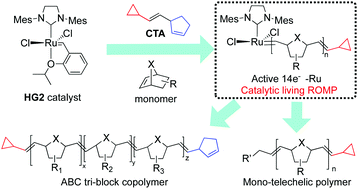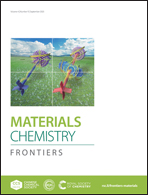Mono-telechelic polymers by catalytic living ring-opening metathesis polymerization with second-generation Hoveyda–Grubbs catalyst†
Abstract
The second-generation Hoveyda–Grubbs (HG2) catalyst, which has a small initiation to propagation rate ratio (ki/kp) in ring-opening metathesis polymerization (ROMP), was successfully used in a recently developed catalytic living ROMP. This proved that slow-initiating catalysts can enable ROMP in a living fashion to produce polymers with narrow dispersity and controlled molecular weight. The molecular weight control experiments show a linear relationship between polymer molecular weight and monomer to chain-transfer agent (CTA) ratio. Different norbornene-derivatives can be utilized as monomers. Di-block copolymers and tri-block copolymers can be synthesized either using the first polymer block as macro-CTA or continuously adding different monomers sequentially. Mono-telechelic polymers, with functional end groups such as protected carboxylic acid, alcohol and amine can also be achieved. All polymers were fully characterized using NMR, GPC and MALDI-ToF analytical techniques. This procedure provides access to well-defined end-functional polymers at lower cost and with reduced rare metal residues that might be of interest for biomedical, materials, industrial and academic use.

- This article is part of the themed collection: In Honour of Professor Robert H. Grubbs for His 50-year Contributions in Metathesis


 Please wait while we load your content...
Please wait while we load your content...